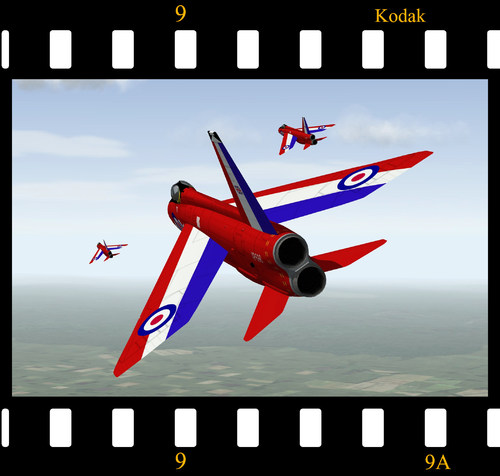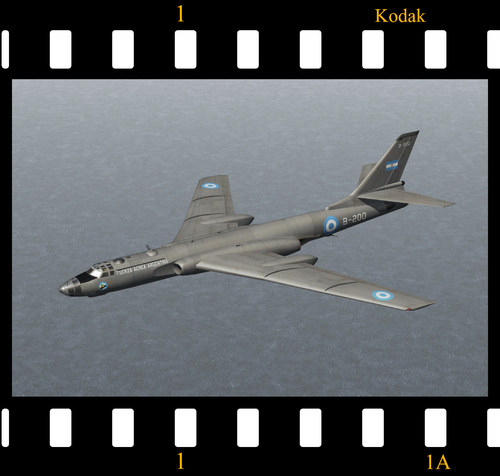-
Content count
9,300 -
Joined
-
Last visited
-
Days Won
497
Content Type
Profiles
Forums
Calendar
Gallery
Downloads
Store
Everything posted by Spinners
-
Version 1.0.0
27 downloads
BAC Lightning F.3 - Red Arrows Aerobatic Display Team This is a simple mod of the stock Lightning F.3 to create a fictional 'Red Arrows' Lightning! You must have the SF2 Expansion Pack 2 installed. Please do not download this if you do not have the Third Wire Lightnings. INSTRUCTIONS 1. From the AIRCRAFT folder drag and drop the LightningF3ra folder into your Aircraft folder. 2. From the DECALS folder drag and drop the LightningF3ra folder into your Decals folder. That's it! CREDITS As always, thanks to Third Wire for a great little game/sim. Special thanks to sundowner for uploading his superb Lightning template to Combat Ace. And, finally, thanks to everyone in the wider Third Wire community. Regards Spinners Version 1 - December 6th, 2023 -

What If Screenshot Thread.......
Spinners replied to Dave's topic in Thirdwire: Strike Fighters 2 Series - Screen Shots
CASA/Dornier C-101 Cernícalo (Spanish Designation C.7) - Escuadron 113, Ejército del Aire, 1965 -

[Fictional] Red Arrows Lightning F.3
Spinners posted a topic in Thirdwire: Strike Fighters 2 Series - File Announcements
View File [Fictional] Red Arrows Lightning F.3 BAC Lightning F.3 - Red Arrows Aerobatic Display Team This is a simple mod of the stock Lightning F.3 to create a fictional 'Red Arrows' Lightning! You must have the SF2 Expansion Pack 2 installed. Please do not download this if you do not have the Third Wire Lightnings. INSTRUCTIONS 1. From the AIRCRAFT folder drag and drop the LightningF3ra folder into your Aircraft folder. 2. From the DECALS folder drag and drop the LightningF3ra folder into your Decals folder. That's it! CREDITS As always, thanks to Third Wire for a great little game/sim. Special thanks to sundowner for uploading his superb Lightning template to Combat Ace. And, finally, thanks to everyone in the wider Third Wire community. Regards Spinners Version 1 - December 6th, 2023 Submitter Spinners Submitted 12/06/2023 Category What If Hangar- 1 reply
-
- 1
-

-
- raf
- red arrows
-
(and 2 more)
Tagged with:
-

What If Screenshot Thread.......
Spinners replied to Dave's topic in Thirdwire: Strike Fighters 2 Series - Screen Shots
Red Arrows Lightnings! -

What If Screenshot Thread.......
Spinners replied to Dave's topic in Thirdwire: Strike Fighters 2 Series - Screen Shots
Republic Aviation Thunderflash FR.1 - No.4 Squadron, RAF Germany, 1958 -

RAF Thunderflashes
Spinners posted a topic in Thirdwire: Strike Fighters 2 Series - Sci-Fi/Anime/What If Forum
Template Credit: Soulfreak A template for the drop tanks is attached. Tank450_RF84F.xcf -

What If Screenshot Thread.......
Spinners replied to Dave's topic in Thirdwire: Strike Fighters 2 Series - Screen Shots
Republic Aviation Thunderflash FR.2 - No.2 Squadron, RAF Germany, 1972 -

SF2 B-25J Mitchell "Night Intruder" Gunship (KAW What-If)
Spinners reviewed Wrench's file in What If Hangar
-

What If Screenshot Thread.......
Spinners replied to Dave's topic in Thirdwire: Strike Fighters 2 Series - Screen Shots
ROCAF Sharks! -

What If Screenshot Thread.......
Spinners replied to Dave's topic in Thirdwire: Strike Fighters 2 Series - Screen Shots
Republic Aviation RF-84F Thunderflash - 119 Squadron, Israeli Air Force, 1967 -

What If Screenshot Thread.......
Spinners replied to Dave's topic in Thirdwire: Strike Fighters 2 Series - Screen Shots
Republic Aviation F-84E Thunderjet - 1st Fighter Squadron, Royal Libyan Air Force, 1960 -

Strike Fighters 2 Screenshots Thread
Spinners replied to Wrench's topic in Thirdwire: Strike Fighters 2 Series - Screen Shots
Roma 1960 -

RAF Thunderstreaks - The Final Years
Spinners replied to Spinners's topic in Thirdwire: Strike Fighters 2 Series - Sci-Fi/Anime/What If Forum
Republic Thunderstreak FGA.2 - No.6 Squadron, RAF Strike Command, 1976 Good call Carlo! -

RAF Thunderstreaks - The Final Years
Spinners posted a topic in Thirdwire: Strike Fighters 2 Series - Sci-Fi/Anime/What If Forum
Republic Thunderstreak FGA.2 - No.234 (Reserve) Squadron, No.1 Tactical Weapons Unit, RAF, 1971- 2 replies
-
- 11
-

-

What If Screenshot Thread.......
Spinners replied to Dave's topic in Thirdwire: Strike Fighters 2 Series - Screen Shots
The Lynx Effect -

Israeli F-84F Thunderstreaks
Spinners replied to Spinners's topic in Thirdwire: Strike Fighters 2 Series - Sci-Fi/Anime/What If Forum
-

Israeli F-84F Thunderstreaks
Spinners posted a topic in Thirdwire: Strike Fighters 2 Series - Sci-Fi/Anime/What If Forum
Template Credit: Ludo.m54 -
Version 2
191 downloads
Tupolev Tu-16 'Badger-A' for STRIKE FIGHTERS 2 This is a very simple mod of the stock AI Third Wire Tu-16 to give a flyable (and fictional) Tu-16 in service with the Fuerza Aérea Argentina with markings for Grupo 1 (grey) and Grupo 2 (silver) in the 1960's to early 1980's era. COCKPIT There is not really a totally suitable pit for this aircraft so I've decided not to include one but you will be sat in the right place (offset to port) and you will have a gun sight and a ground mapping radar. INSTRUCTIONS 1. From the AIRCRAFT folder drag and drop the Tu-16_FAA folder into your Aircraft folder. 2. From the DECALS folder drag and drop the Tu-16_FAA folder into your Decals folder. That's it! FLYING THE BADGER It's so easy to scrape the tail when taking off so let the Badger 'auto take-off' by setting flaps and full power, release the brakes and the nose will lift at 260kmh and it will lift off the runway soon after. I've had good results by releasing my bombs at 10km away from the target whilst at 6,000m altitude but the Badger will happily cruise at 9,000m and at that height you should release your bombs at about 12km away from the target or just a bit more. Remember that the Badger has a fixed forward-firing 23mm cannon so if your bombs miss the fuel tank then get down nice and low and take it out that way! To help you land the Badger I've added fake airbrakes which will slow you down enough so it's just a matter of lining up the runway from a fair old distance and making a nice 'greaser' of a landing. It does sometimes help to push the stick forward to overcome the bounciness of the landing gear. CREDITS As always, thanks to Third Wire for a great little game/sim. And, finally, thanks to everyone in the wider Third Wire community. Regards Spinners Version 2 - October 28th, 2023- 1 comment
-
- 2
-

-
- fuerza aérea argentina
- badger
-
(and 2 more)
Tagged with:
-
Version 2
127 downloads
Dassault Mirage IIICI 'Irelande' for STRIKE FIGHTERS 2 This is a very simple mod of the stock Third Wire Mirage IIIC to give a fictional Irish Air Corps Mirage IIICI with equally fictitious markings for No.1 'Black Velvet' squadron. INSTRUCTIONS 1. From the AIRCRAFT folder drag and drop the Mirage3CI folder into your Aircraft folder. 2. From the DECALS folder drag and drop the Mirage3CI folder into your Decals folder. That's it! CREDITS As always, thanks to Third Wire for a great little game/sim. And, finally, thanks to everyone in the wider Third Wire community. Regards Spinners Version 2 - November 16th, 2023 -

Israeli F-84F Thunderstreaks
Spinners replied to Spinners's topic in Thirdwire: Strike Fighters 2 Series - Sci-Fi/Anime/What If Forum
-

What If Screenshot Thread.......
Spinners replied to Dave's topic in Thirdwire: Strike Fighters 2 Series - Screen Shots
Republic F-84I Thunderstreak - No.140 Squadron, Israeli Air Force, 1956 -

What If Screenshot Thread.......
Spinners replied to Dave's topic in Thirdwire: Strike Fighters 2 Series - Screen Shots
Republic Thunderstreak FGA.2 - No.41 Squadron, RAF Fighter Command, 1965 -

What If Screenshot Thread.......
Spinners replied to Dave's topic in Thirdwire: Strike Fighters 2 Series - Screen Shots
Fire... and Brimstone! -

What If Screenshot Thread.......
Spinners replied to Dave's topic in Thirdwire: Strike Fighters 2 Series - Screen Shots
Republic Thunderstreak FGA.1 - No.67 Squadron, RAF Germany, 1956




